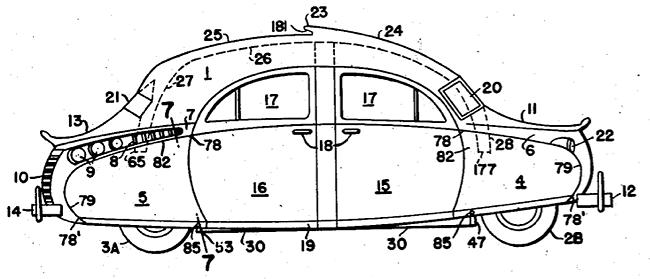Atomic Bomb Car

In 1953, Corwin D. Willson of Flint, Michigan patented the Atomic Bomb Car. Though the official title on the patent was a "sedan having versatile structure."
His idea was that if the United States were "atomically attacked," people would need to flee the cities, and then they'd have to live in their cars. But most cars aren't designed to be lived in. The solution: turn cars into mobile bomb shelters that could provide temporary housing for people. Essentially, he was patenting a camper car, but he was trying to market it as a defense against atomic attack.
From the patent:
Obviously, today's family car, while as numerous as dwellings, would fail, under threat of atomic attack, to meet the needs of millions of families simultaneously for widely diffused family shelter during an emergency probably timed to occur in mid-winter and to be of some duration. yet, once some practical: i.e., simple and economically possible, means is found for making the average car quickly convertible to housekeeping use, then the threat of the atom bomb to our cities loses some of its menace.
And also:
It is commonly acknowledged that the physical structures of congested areas are doomed once atomically attacked, The real problem is: how sensibly to save the lives of the inhabitants of cities thus marked for destruction and temporarily house them so that the business of resistance may go on in spite of the chaos engendered? Americans own as many motorcars as dwellings: 30,000,000 cars. If these cars were built as taught herein and if the civilian masses, against whom the next war acknowledgedly will be waged, were trained to diffuse in an orderly fashion to points prepared in advance and to occupy their convertible motorcars as temporary family dwellings till the danger passed, then one of the greatest problems to face the coming generation would have found a simple, economically sound and eminently satisfying solution.
More info: JF Ptak Science Books, Patent #US2638374A
Comments
I just had to scan the word "toilet" to see how much thought was devoted to that necessary chore. Three mentions but no practical description as to how it would work. Considering how long one would have to occupy the shelter before the radiation levels fell, I wouldn't want one.
Posted by KDP on 03/27/17 at 03:10 PM
Commenting is not available in this channel entry.

Category: Inventions | Patents | Atomic Power and Other Nuclear Matters | 1950s